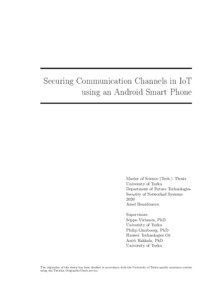Securing Communication Channels in IoT using an Android Smart Phone
Bourdoucen, Amel (2020-06-26)
Securing Communication Channels in IoT using an Android Smart Phone
Bourdoucen, Amel
(26.06.2020)
Lataukset:
Julkaisu on tekijänoikeussäännösten alainen. Teosta voi lukea ja tulostaa henkilökohtaista käyttöä varten. Käyttö kaupallisiin tarkoituksiin on kielletty.
avoin
Julkaisun pysyvä osoite on:
https://urn.fi/URN:NBN:fi-fe2020081961095
https://urn.fi/URN:NBN:fi-fe2020081961095
Tiivistelmä
In today's world, smart devices are a necessity to have, and represent an essential tool for performing daily activities. With this comes the need to secure the communication between the IoT devices in the consumer's home, to prevent attacks that may jeopardize the confidentiality and integrity of communication between the IoT devices.
The life cycle of a a simple device includes a series of stages that the device undergoes: from construction and production to decommissioning. In this thesis, the Manufacturing, Bootstrapping and Factory Reset parts of IoT device's life cycle are considered, focusing on security. For example, the Controller of user's home network (e.g., user's smart phone) should bootstrap the ``right'' IoT device and the IoT device should bootstrap with the ``right'' Controller.
The security is based on device credentials, such as the device certificate during the bootstrapping process, and the operational credentials that are provisioned to the IoT device from the Controller during the bootstrapping.
The goal of this thesis is to achieve easy-to-use and secure procedure for setting up the IoT device into a home network, and for controlling that IoT device from an Android mobile phone (Controller). The objectives are: (1) explore the different aspects of using a smartphone as a Controller device to securely manage the life cycle of a simple device; (2) propose a system design for securely managing the life cycle of a simple device from a Controller compliant with existing standards, (e.g. Lightweight Machine to Machine (LwM2M) is an industrial standard used to manage and control industrial IoT Devices); (3) implement a proof of concept based on the system design; (4) provide a user-friendly interface for a better experience for the user by using popular bootsrapping methods such as QR code scanning; (5) discuss the choices regarding securing credentials and managing data, and achieve a good balance between usability and security during the bootstrapping process.
In order to achieve those goals, the state-of-art technologies for IoT device management were studied. Then an Android application that uses LwM2M standard in consumer's home setting was specified, designed and implemented. The Android application is wrapped in a smooth user interface that allows the user a good experience when attempting to connect and control the target IoT device.
The life cycle of a a simple device includes a series of stages that the device undergoes: from construction and production to decommissioning. In this thesis, the Manufacturing, Bootstrapping and Factory Reset parts of IoT device's life cycle are considered, focusing on security. For example, the Controller of user's home network (e.g., user's smart phone) should bootstrap the ``right'' IoT device and the IoT device should bootstrap with the ``right'' Controller.
The security is based on device credentials, such as the device certificate during the bootstrapping process, and the operational credentials that are provisioned to the IoT device from the Controller during the bootstrapping.
The goal of this thesis is to achieve easy-to-use and secure procedure for setting up the IoT device into a home network, and for controlling that IoT device from an Android mobile phone (Controller). The objectives are: (1) explore the different aspects of using a smartphone as a Controller device to securely manage the life cycle of a simple device; (2) propose a system design for securely managing the life cycle of a simple device from a Controller compliant with existing standards, (e.g. Lightweight Machine to Machine (LwM2M) is an industrial standard used to manage and control industrial IoT Devices); (3) implement a proof of concept based on the system design; (4) provide a user-friendly interface for a better experience for the user by using popular bootsrapping methods such as QR code scanning; (5) discuss the choices regarding securing credentials and managing data, and achieve a good balance between usability and security during the bootstrapping process.
In order to achieve those goals, the state-of-art technologies for IoT device management were studied. Then an Android application that uses LwM2M standard in consumer's home setting was specified, designed and implemented. The Android application is wrapped in a smooth user interface that allows the user a good experience when attempting to connect and control the target IoT device.
